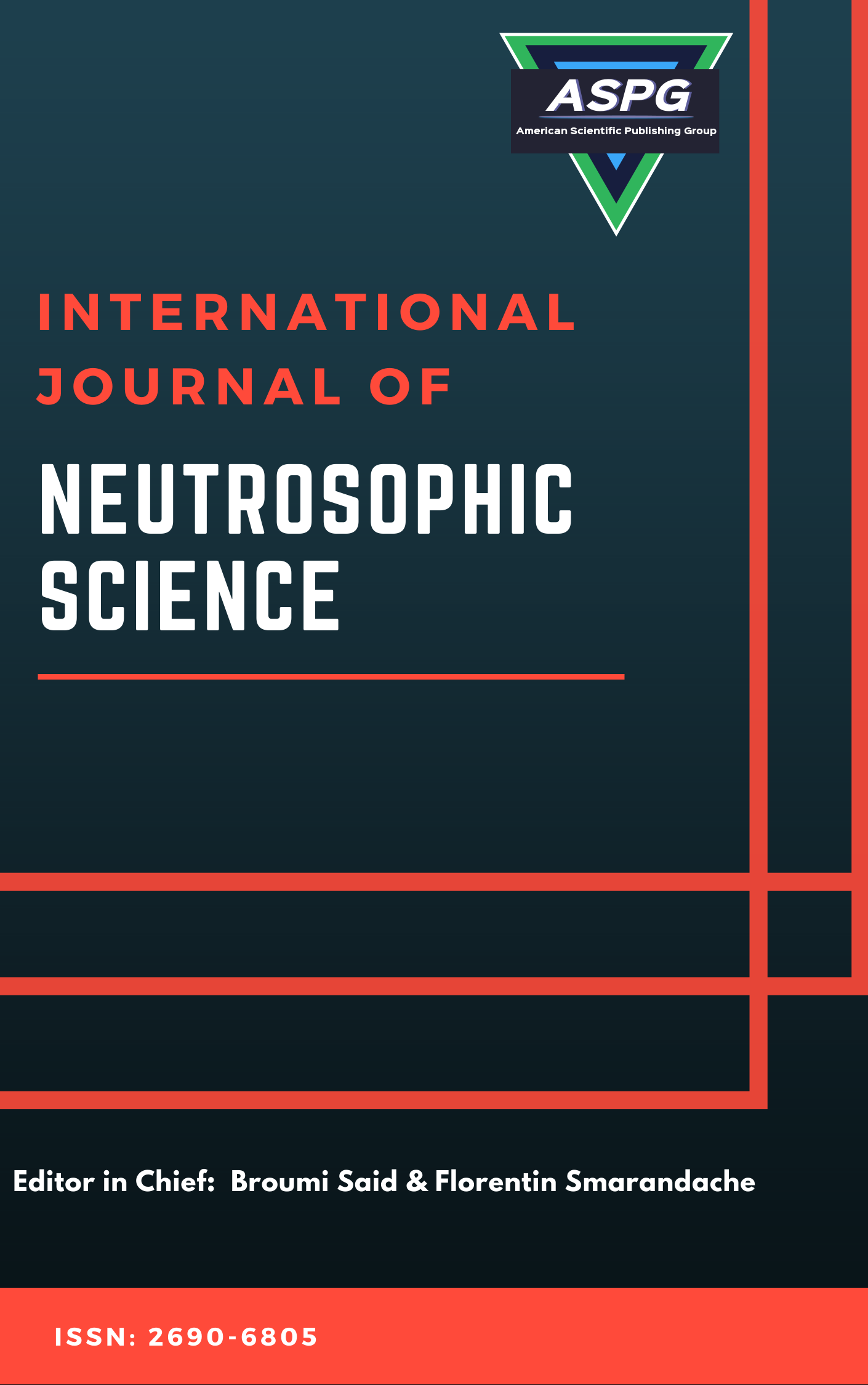

Volume 27 , Issue 2 , PP: 68-78, 2026 | Cite this article as | XML | Html | PDF | Full Length Article
Mansour F. Yassen 1 , Adnan Amin 2 *
Doi: https://doi.org/10.54216/IJNS.270207
Healthcare data often involve uncertainty, imprecision, and partial information that are hardly handled by classical statistical models. Here, we propose a new generalization of the Gamma Lomax (GL) distribution under the neutrosophic environment, referred to as the neutrosophic Gamma Lomax (NGL) distribution, to overcome this drawback. In addition, the proposed model can be generalized to handle precise as well as uncertain healthcare data by incorporating neutrosophic logic including truth, falsity and indeterminacy. The classical properties of the Gamma-Lomax (GL) distribution are examined alongside their neutrosophic counterparts. Graphical representations, including density plots and associated reliability functions of the proposed model, are presented. The maximum likelihood estimation (MLE) is applied to find unknown parameters. The neutrosophic model is capable of modeling interval-valued results and uncertainties in practical data, and its effectiveness is verified by simulation studies and an illustration with infant mortality rates. The new method is conducive to the interpretability and credibility of statistical inference under uncertainty and is of high utility in health decision-making scenarios.
Gamma model , Neutrosophic logic , Neutrosophic density , Neutrosophic estimation
[1] E. A. A. Hassan, M. Elgarhy, E. A. Eldessouky, O. H. M. Hassan, E. A. Amin, and E. M. Almetwally, "Different estimation methods for new probability distribution approach based on environmental and medical data," Axioms, vol. 12, no. 2, p. 220, 2023.
[2] A. Viti, A. Terzi, and L. Bertolaccini, "A practical overview on probability distributions," Journal of Thoracic Disease, vol. 7, no. 3, p. E7, 2015.
[3] R. Alizadehsani et al., "Handling of uncertainty in medical data using machine learning and probability theory techniques: A review of 30 years (1991–2020)," Annals of Operations Research, vol. 339, no. 3, pp. 1077–1118, 2024.
[4] A. A. Bartolucci, K. P. Singh, A. D. Bartolucci, and S. Bae, "Applying medical survival data to estimate the three-parameter Weibull distribution by the method of probability-weighted moments," Mathematics and Computers in Simulation, vol. 48, no. 4–6, pp. 385–392, 1999.
[5] G. M. Cordeiro, E. M. M. Ortega, and G. O. Silva, "The exponentiated generalized gamma distribution with application to lifetime data," Journal of Statistical Computation and Simulation, vol. 81, no. 7, pp. 827–842, 2011.
[6] W. Almutiry, A. A. Alahmadi, I. Elbatal, I. E. Ragab, O. S. Balogun, and M. Elgarhy, "Application to engineering and medical data using three-parameter exponential model," Mobile Information Systems, vol. 2021, Art. no. 9550156, 2021.
[7] A.-Z. M. Oda and K. A. Al-Kadim, "Modeling healthy data with new alpha power inverse Weibull distribution," in International Conference on Mathematical Modeling and Computational Science, pp. 449–457, 2025.
[8] M. Rasheed, "Analyzing applications and properties of the exponential continuous distribution in reliability and survival analysis," Journal of Positive Sciences, vol. 4, no. 5, pp. 71–79, 2023.
[9] G. M. Cordeiro, E. M. M. Ortega, and B. V. Popović, "The gamma-Lomax distribution," Journal of Statistical Computation and Simulation, vol. 85, no. 2, pp. 305–319, 2015.
[10] A. A. Ogunde, O. I. Oseghale, S. A. Phillips, and D. O. Omosigho, "Gamma generalized power Lomax: A novel distribution in modelling COVID-19 data," International Journal of Mathematical Sciences and Optimization: Theory and Applications, vol. 9, no. 1, pp. 138–147, 2023.
[11] A. J. Lemonte and G. M. Cordeiro, "An extended Lomax distribution," Statistics, vol. 47, no. 4, pp. 800–816, 2013.
[12] C. T. Chen, "A fuzzy approach to select the location of the distribution center," Fuzzy Sets and Systems, vol. 118, no. 1, pp. 65–73, 2001.
[13] G. Souliotis, Y. Alanazi, and B. Papadopoulos, "Construction of fuzzy numbers via cumulative distribution function," Mathematics, vol. 10, no. 18, p. 3350, 2022.
[14] R. Mehta, "Multivariate fuzzy logic based smart healthcare monitoring for risk evaluation of cardiac patients," in Medical Informatics and Bioimaging Using Artificial Intelligence: Challenges, Issues, Innovations and Recent Developments, pp. 219–243, 2021.
[15] R. Khushal and U. Fatima, "Fuzzy computing in healthcare," in Proc. 2024 International Visualization, Informatics and Technology Conference (IVIT), pp. 78–83, 2024.
[16] G. Gürsel, "Healthcare, uncertainty, and fuzzy logic," Digital Medicine, vol. 2, no. 3, pp. 101–112, 2016.
[17] S. Broumi, A. Bakali, and A. Bahnasse, "Neutrosophic sets: An overview," Infinite Study, vol. 410, no. 1, 2018.
[18] R. Alhabib, M. Ranna, H. Farah, and A. A. Salama, "Some neutrosophic probability distributions," Infinite Study, 2018.
[19] F. Smarandache, "Introduction to neutrosophic measure, neutrosophic integral, and neutrosophic probability," Infinite Study, 2013.
[20] F. A. Alshahrani and M. E. Ghitany, "A new approach to neutrosophic statistical modeling in healthcare," Journal of Healthcare Engineering, vol. 2024, Art. no. 987654, 2024.
[21] A. M. Khosravi and R. Zakerzadeh, "Neutrosophic probability distributions and their applications in risk assessment," Journal of Applied Statistics, vol. 51, no. 1, pp. 45–60, 2023.
[22] World Health Organization, "Saudi Arabia: Infant mortality rate (under-5 per 1,000 live births)," 2024. [Online]. Available: https://www.who.int/data/gho/data/indicators, [Accessed: Jun. 24, 2025].